Portal:University of Oxford/Nominate/Selected picture
Nominate more...
Articles • Biographies • Colleges • DYKs • Panoramas • Pictures • Quotations
You may be able to find additional high-quality and interesting images relating to the university, its colleges and people at commons:Category:University of Oxford (and its sub-categories). If you have taken an image that you are prepared to release under a free license or into the public domain, please upload it at Commons; please do the same with other freely licensed or public domain images. Files that can only be used on Wikipedia under a claim of fair use cannot be used on portals.
If you wish to add a photograph for rotation within this portal, and it has already been uploaded, please follow these steps:
- Add the image in to a subpage of this portal, such as Portal:University of Oxford/Selected picture/#, replacing the "#" with the number above the current highest. For example, if 30 images are in rotation, you would make the number of the page you are creating 31.
- Use the following format, to match the other images used:
{{Portal:University of Oxford/Selected picture/Layout
|image=NAME OF IMAGE (without "Image" or "File")
|text=CAPTION, with appropriate wikilinks and a link to the most closely associated article in '''[[bold]]'''
|credit=Photographer's name, with wikilink to userpage (on the English Wikipedia or on Commons, as appropriate) or as an external link to the photographer's Flickr page etc
}}
- Update the picture maximum parameter on the main Portal
- Update this list accordingly.
Selected picture
Portal:University of Oxford/Selected picture/1

Established in 1870 as a memorial to the clergyman John Keble, a leading member of the Oxford Movement, Keble College (chapel pictured) remains distinctive for its neo-gothic red-brick buildings designed by William Butterfield.
Portal:University of Oxford/Selected picture/4

Old book bindings in the college library of Merton College. The college dates from the 1260s and is one of the contenders (along with University College and Balliol College) for the title of the first-established college. The oldest part of the library dates from 1373. The library holds approximately 70,000 volumes and 300 medieval manuscripts.
Portal:University of Oxford/Selected picture/6

Stained glass in Christ Church Cathedral, Oxford. The chapel of Christ Church also serves as a cathedral for the Diocese of Oxford, a unique combination of university chapel and cathedral.
Portal:University of Oxford/Selected picture/8

The sundial pillar in the quadrangle of Corpus Christi College. The college, one of the smallest in terms of student numbers, was founded by Richard Foxe, the Bishop of Winchester, in 1517. The sundial pillar was added in 1581.
Portal:University of Oxford/Selected picture/11
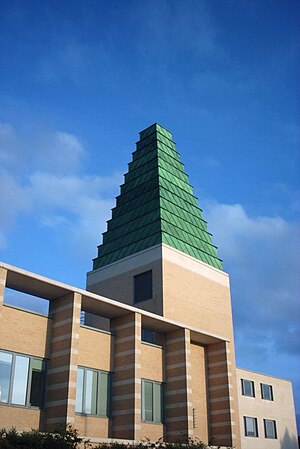
The contemporary approach to the "dreaming spire" taken by the Saïd Business School. The School was established at the University of Oxford in 1996, and the buildings were completed in 2001.
Portal:University of Oxford/Selected picture/12
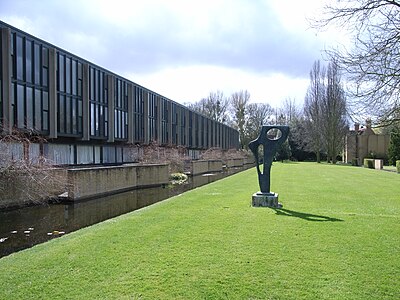
A statue by Barbara Hepworth at St Catherine's College. Built in the 1960s to the design of the Danish architect Arne Jacobsen, the college's architecture has been highly praised.
Portal:University of Oxford/Selected picture/17
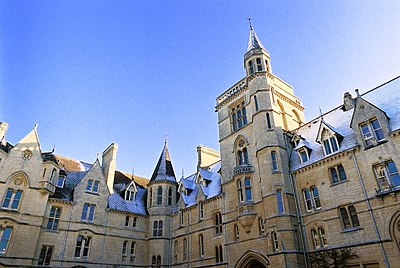
The front quadrangle of Balliol College. Founded in 1263, Balliol's alumni include four British prime ministers: H. H. Asquith, Harold Macmillan, Edward Heath and Boris Johnson.
Portal:University of Oxford/Selected picture/18

A winter view of Oxford from South Park on Headington Hill, to the east of the city.
Portal:University of Oxford/Selected picture/19

A men's crew from Keble College training for Eights Week (the main inter-college rowing races). Rowing is a popular student sport at Oxford, even though most students will not have rowed before starting at Oxford.
Portal:University of Oxford/Selected picture/20

Part of the Inorganic Chemistry building in the Science Area on South Parks Road. Oxford has the biggest school of inorganic chemistry in the UK and one of the biggest in the world.
Portal:University of Oxford/Selected picture/22

The tower of Magdalen College seen from the University of Oxford Botanic Garden. Established in 1621 as a physic garden growing plants for medicinal research, it contains over 8,000 different plant species.
Portal:University of Oxford/Selected picture/23
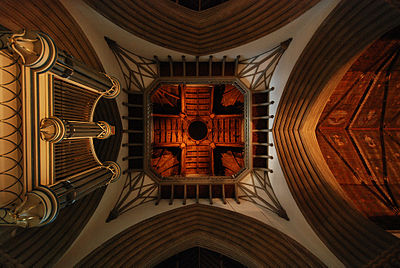
The interior of the college chapel of Merton College. The chapel replaced an earlier church on the site, with construction beginning in about 1290 and continuing into the 15th century.
Portal:University of Oxford/Selected picture/26

The cloisters of New College. Founded in 1379 by William of Wykeham, Bishop of Winchester, the college has educated distinguished names such as the author John Galsworthy, the legal philosopher H. L. A. Hart and the art historian Neil MacGregor.
Portal:University of Oxford/Selected picture/28

The spire of the chapel of Exeter College, pictured from Broad Street late on an October afternoon.
Portal:University of Oxford/Selected picture/30
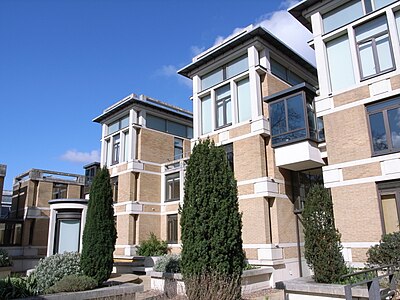
The Garden Quadrangle at St John's College, built between 1989 and 1993 by MJP Architects. The college was founded in 1555 by Sir Thomas White, a merchant and Master of the Worshipful Company of Merchant Taylors. A number of buildings in modern styles have been added to the college since the 1950s.
Portal:University of Oxford/Selected picture/38

Construction of the chapel of Wadham College began soon after the college was founded in 1610 and it was consecrated on 29 April 1613. The stained glass of the east window was added in 1622.
Portal:University of Oxford/Selected picture/39

The dining hall of Balliol College was built in 1876–77 by Alfred Waterhouse, replacing an early 15th-century hall (which was then used as a library).
Portal:University of Oxford/Selected picture/40
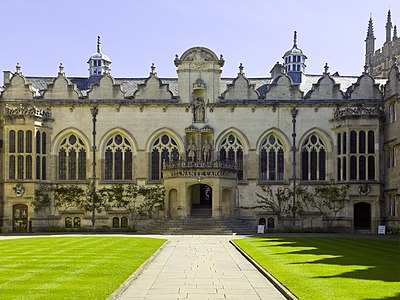
The hall on the east side of the first quadrangle of Oriel College. The college was founded in 1324; the hall dates from the mid-17th century.

Established in 1870 as a memorial to the clergyman John Keble, a leading member of the Oxford Movement, Keble College (chapel pictured) remains distinctive for its neo-gothic red-brick buildings designed by William Butterfield.
Chancellor of the University of Oxford, Lord Patten of Barnes, leaves the Sheldonian Theatre after the 2009 Encaenia
. He was elected in 2003, and is the latest holder of an office that dates back to the early 13th century.
The
Chancellor of the University of Oxford, Lord Patten of Barnes, leaves the Sheldonian Theatre after the 2009 Encaenia
. He was elected in 2003, and is the latest holder of an office that dates back to the early 13th century.King Henry VIII
's favour before the college was complete, and the monarch refounded it in 1546 under its present name.
King Henry VIII
's favour before the college was complete, and the monarch refounded it in 1546 under its present name.Portal:University of Oxford/Selected picture/4

Old book bindings in the college library of Merton College. The college dates from the 1260s and is one of the contenders (along with University College and Balliol College) for the title of the first-established college. The oldest part of the library dates from 1373. The library holds approximately 70,000 volumes and 300 medieval manuscripts.
John Radcliffe. Designed by James Gibbs
, it is the earliest example in England of a circular library.
The
John Radcliffe. Designed by James Gibbs
, it is the earliest example in England of a circular library.Portal:University of Oxford/Selected picture/6

Stained glass in Christ Church Cathedral, Oxford. The chapel of Christ Church also serves as a cathedral for the Diocese of Oxford, a unique combination of university chapel and cathedral.
Sainte Chapelle
, Paris.
The chapel of
Sainte Chapelle
, Paris.Portal:University of Oxford/Selected picture/8

The sundial pillar in the quadrangle of Corpus Christi College. The college, one of the smallest in terms of student numbers, was founded by Richard Foxe, the Bishop of Winchester, in 1517. The sundial pillar was added in 1581.
Magdalen Tower
.
Magdalen Tower
.Bridge of Sighs, at Hertford College. The bridge, designed by Thomas Graham Jackson, links the Old and New Quadrangles of the college, which are on opposite sides of New College Lane
. It was completed in 1914.
Hertford Bridge, also known as the
Bridge of Sighs, at Hertford College. The bridge, designed by Thomas Graham Jackson, links the Old and New Quadrangles of the college, which are on opposite sides of New College Lane
. It was completed in 1914.Portal:University of Oxford/Selected picture/11

The contemporary approach to the "dreaming spire" taken by the Saïd Business School. The School was established at the University of Oxford in 1996, and the buildings were completed in 2001.
Portal:University of Oxford/Selected picture/12

A statue by Barbara Hepworth at St Catherine's College. Built in the 1960s to the design of the Danish architect Arne Jacobsen, the college's architecture has been highly praised.
Society of Jesus. The buildings were designed in the 1930s by the architect Edwin Lutyens
.
The doorway of
Society of Jesus. The buildings were designed in the 1930s by the architect Edwin Lutyens
.Fellows
.
Fellows
.Perpendicular style
, the Divinity School is Oxford's oldest surviving purpose-built building for university use.
Part of the ceiling of the
Perpendicular style
, the Divinity School is Oxford's oldest surviving purpose-built building for university use.astronomical observatory from 1773 until 1934. The building is now part of Green Templeton College
.
The top of the
astronomical observatory from 1773 until 1934. The building is now part of Green Templeton College
.Portal:University of Oxford/Selected picture/17

The front quadrangle of Balliol College. Founded in 1263, Balliol's alumni include four British prime ministers: H. H. Asquith, Harold Macmillan, Edward Heath and Boris Johnson.
Portal:University of Oxford/Selected picture/18

A winter view of Oxford from South Park on Headington Hill, to the east of the city.
Portal:University of Oxford/Selected picture/19

A men's crew from Keble College training for Eights Week (the main inter-college rowing races). Rowing is a popular student sport at Oxford, even though most students will not have rowed before starting at Oxford.
Portal:University of Oxford/Selected picture/20

Part of the Inorganic Chemistry building in the Science Area on South Parks Road. Oxford has the biggest school of inorganic chemistry in the UK and one of the biggest in the world.
William of Waynflete, Bishop of Winchester
, and the tower was built between 1492 and 1509.
William of Waynflete, Bishop of Winchester
, and the tower was built between 1492 and 1509.Portal:University of Oxford/Selected picture/22

The tower of Magdalen College seen from the University of Oxford Botanic Garden. Established in 1621 as a physic garden growing plants for medicinal research, it contains over 8,000 different plant species.
Portal:University of Oxford/Selected picture/23

The interior of the college chapel of Merton College. The chapel replaced an earlier church on the site, with construction beginning in about 1290 and continuing into the 15th century.
Literae Humaniores
(classics).
Literae Humaniores
(classics).Henry VIII and served as High Steward of the University. He was imprisoned and beheaded in 1535 after he had fallen out of favour with the king over his refusal to sign the Act of Supremacy 1534
.
Henry VIII and served as High Steward of the University. He was imprisoned and beheaded in 1535 after he had fallen out of favour with the king over his refusal to sign the Act of Supremacy 1534
.Portal:University of Oxford/Selected picture/26

The cloisters of New College. Founded in 1379 by William of Wykeham, Bishop of Winchester, the college has educated distinguished names such as the author John Galsworthy, the legal philosopher H. L. A. Hart and the art historian Neil MacGregor.
Fellow
of the college.
The quadrangle of
Fellow
of the college.Portal:University of Oxford/Selected picture/28

The spire of the chapel of Exeter College, pictured from Broad Street late on an October afternoon.
Tyrannosaurus rex, one of the exhibits on display at the Pitt Rivers Museum. Founded in 1884 by Augustus Pitt Rivers
, the museum holds about 500,000 items donated to the University relating to archaeology and anthropology.
Tyrannosaurus rex, one of the exhibits on display at the Pitt Rivers Museum. Founded in 1884 by Augustus Pitt Rivers
, the museum holds about 500,000 items donated to the University relating to archaeology and anthropology.Portal:University of Oxford/Selected picture/30

The Garden Quadrangle at St John's College, built between 1989 and 1993 by MJP Architects. The college was founded in 1555 by Sir Thomas White, a merchant and Master of the Worshipful Company of Merchant Taylors. A number of buildings in modern styles have been added to the college since the 1950s.
Mary heir, rather than the newborn Catholic James Francis Edward Stuart
.
Mary heir, rather than the newborn Catholic James Francis Edward Stuart
.Hilary Term
1999.
A
Hilary Term
1999.Pembroke
.
Pembroke
.Boat Race on the River Thames
in London; Oxford and Cambridge first rowed against each other in 1829, and the Boat Race has been held annually since 1856 apart from the two World Wars.
The course of the
Boat Race on the River Thames
in London; Oxford and Cambridge first rowed against each other in 1829, and the Boat Race has been held annually since 1856 apart from the two World Wars.William Arnold
.
William Arnold
.High Table
for the college's Fellows. Instead, they dine alongside the students, who are all carrying out postgraduate work.
Unlike most other colleges at Oxford, the dining hall at
High Table
for the college's Fellows. Instead, they dine alongside the students, who are all carrying out postgraduate work.beatified by Pope Benedict XVI
in 2010.
beatified by Pope Benedict XVI
in 2010.Portal:University of Oxford/Selected picture/38

Construction of the chapel of Wadham College began soon after the college was founded in 1610 and it was consecrated on 29 April 1613. The stained glass of the east window was added in 1622.
Portal:University of Oxford/Selected picture/39

The dining hall of Balliol College was built in 1876–77 by Alfred Waterhouse, replacing an early 15th-century hall (which was then used as a library).
Portal:University of Oxford/Selected picture/40

The hall on the east side of the first quadrangle of Oriel College. The college was founded in 1324; the hall dates from the mid-17th century.
